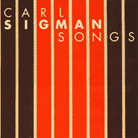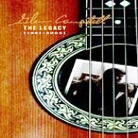December 2003
I doubt that songwriter Carl Sigman, who died in 2000 at age 91, thought of himself as anything but a craftsman who wrote songs for the hit parade. Of course, it follows that he wrote them well and that many of them endure as prime examples of songwriting art. Sigman’s name appears as writer or co-writer on over 800 copyrighted songs, including "Ebb Tide," "Pennsylvania 6-5000," "Buona Sera," and "(Where Do I Begin) Love Story." I can’t imagine a songwriter who can match the astonishing number and variety of singers who covered his material, among them Louis Armstrong, Billie Holiday, Louis Prima, Sinatra, Merle Haggard, Van Morrison, and the Specials. Carl Sigman -- Songs, gathers together 76 recordings of his songs on three CDs, beginning in 1938 with "Just Remember" and continuing through the next six decades. We get the chance to evaluate how well Sigman’s work travels by comparing, for example, five versions of "It’s All in the Game." Tommy Edwards hit with the song twice and there’s a tremendous difference between his 1951 attempt, which went to #18, and the soulful, doo-wop arrangement that spent six weeks at # 1 in 1958. The Four Tops, Van Morrison, and Merle Haggard also cover the tune and each of them has a unique understanding of the song’s simple romanticism. Sigman wasn’t a fancy lyricist --- his poetry was in his clarity and concision. The lyrics to "Ebb Tide" (four versions here) were probably the showiest he ever wrote:
The set gives us a chance to hear pop music, especially pop singing, as it developed over the years. Billie Holiday sang "Crazy He Calls Me" a year before Vanghn Monroe recorded "No Range to Ride Anymore," but Monroe seems to be calling to us from a distant century, while Holiday’s voice continues to echo in the styles of singers today. Sigman himself comes back to us over the decades because so many singers return to his straightforward, expressive lyrics and to the melodies he and his collaborators created. You can often tell which tunes Sigman did strictly as a writer for hire -- "No Range to Ride Anymore" or the theme to the TV show Robin Hood seem to fit that description -- but even those show his intelligence and care. As the liner notes to Carl Sigman -- Songs suggest, you’ll be surprised at how many of these songs you know without realizing who wrote them. You’ll also be delighted at how many great songs carry the Sigman name. Glen Campbell, like Carl Sigman, is notable for the high level of professionalism he brings to his work. Campbell’s career trajectory in the late '60s -- hit singles, followed by a TV variety show and some movie work -- seemed to follow the example of song-and-dance men from an earlier era. Nothing much came of his movie career, but his variety show on CBS, The Glen Campbell Goodtime Hour, did well from 1969 until 1972. In the end, though, Campbell’s fame rests on his music, and Capitol Records has chosen 65 of his studio recordings, plus a CD of live recordings from several stages in his career, for a four-CD set, The Legacy. Campbell’s singles in the late '60s were as much a part of the time as those of the more revolutionary rock and soul musicians whose songs charted beside his. Campbell seemed to straddle the old and new -- the production on his records rang a little bit square, but his songs captured some of the same spirit of the time that his contemporaries’ did. The slightly hip edge came from his choice of material. Many of Campbell’s early hits -- " By the Time I Get to Phoenix," "Wichita Lineman," "Galveston" -- were written by Jimmy Webb, a songwriter whose critical cachet has remained high over the years (somewhat oddly for a writer whose hits were recorded primarily by MOR artists). Campbell’s transcendent moment was on a song by another good writer, John Hartford. "Gentle On My Mind," one of the great singles of the late '60s, took a pop music cliché -- ramblin’ -- and managed to pull poetry out of it. The song features a calm, understated vocal by Campbell and tasteful backing by James Burton, Doug Dillard, Jim Gordon, and Joe Osborn. The names of other great session players show up throughout the credits to The Legacy, including Hal Blaine, Carol Kaye, Fred Tackett, Leland Sklar, and Billy Joe Walker, Jr. Unfortunately, the straightforward arrangement of "Gentle On My Mind" was not to be the blueprint for Campbell’s success. Even his best recordings had treacly strings and horns imposed on them later (the credits for nearly every track list "overdub musicians"). Campbell’s taste in songs and the quality of the basic rhythm track usually outshine the slick veneer, but sometimes you have to work hard to ignore it. The late-'60s/early-'70s production contains some sonic oddities -- strings in the left channel with the drums trying to fight their way through them, horns in the hard right overpowering the bass -- but nothing that wasn’t common in soul or pop recordings of the time. The remastering on the set is good, though not exceptional. The third disc, comprising recordings from 1975-1993, has some cleaner arrangements and songs like "The Highwayman" (Jimmy Webb again) that should have been hits for Campbell, but one begins to feel that Campbell was losing his ear for good songwriting. The live disc is, I think, wasted -- too many Las Vegas touches and only one or two enjoyable tracks ("Amazing Grace, " "The Highwayman"). For me the biggest disappointment about The Legacy is that there’s very little of Glen Campbell the guitarist. I don’t think he’s ever committed a recording to wax that’s ever showed his amazing abilities as a guitar player. I’m only aware of them because I’ve caught him on a few TV shows over the years where he let loose. In every one of those cases, it was on another musician’s turf -- Jerry Reed’s or Willy Nelson’s, for example -- that he felt comfortable enough to show off. As a comprehensive look at an entertaining career, The Legacy is solid and enjoyable (it’s worth owning for "Guess I’m Dumb," a single Brian Wilson wrote and produced for Campbell in 1965). But before Glen Campbell retires to play golf full time, I’d love to hear him do an instrumental album that showcases his extraordinary playing. The liner notes tell us he’s a fan of Django Reinhardt. Maybe Mark O’Connor could join him for a tribute to the Quintet of the Hot Club of Paris. We can dream. GO BACK TO: |
 Carl Sigman - Songs
Carl Sigman - Songs Glen Campbell - The Legacy (1961-2002)
Glen Campbell - The Legacy (1961-2002) It’s hard for
many of us to fathom that there was a time when pop musicians, singers, and songwriters
didn’t think of themselves as artists with a capital "A." Even Elvis
Presley considered himself primarily an entertainer and his goal was to match the success
of other multi-talented stars who preceded him, people like Bing Crosby, Frank Sinatra, or
Dean Martin (a favorite of Presley’s). The truth is that all four of them created art
(I’ll leave you to decide if Martin did it as a singer), but it wasn’t a
conscious decision -- they approached what they did as a craft, something they wanted to
do well. These days, by contrast, everyone wants to be an Artist, from boy-band singers to
guys who write advertising jingles.
It’s hard for
many of us to fathom that there was a time when pop musicians, singers, and songwriters
didn’t think of themselves as artists with a capital "A." Even Elvis
Presley considered himself primarily an entertainer and his goal was to match the success
of other multi-talented stars who preceded him, people like Bing Crosby, Frank Sinatra, or
Dean Martin (a favorite of Presley’s). The truth is that all four of them created art
(I’ll leave you to decide if Martin did it as a singer), but it wasn’t a
conscious decision -- they approached what they did as a craft, something they wanted to
do well. These days, by contrast, everyone wants to be an Artist, from boy-band singers to
guys who write advertising jingles.